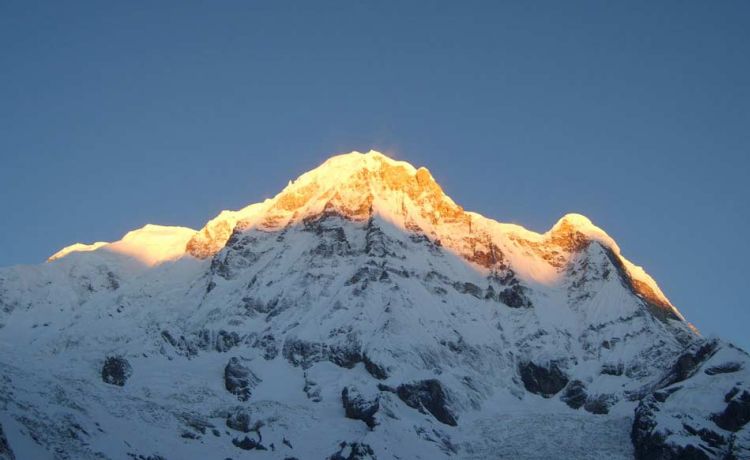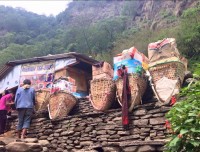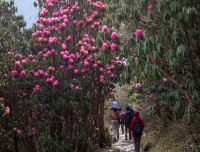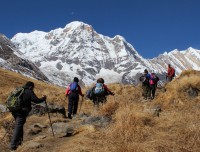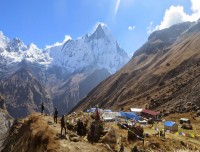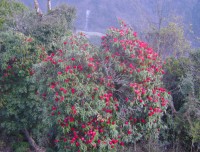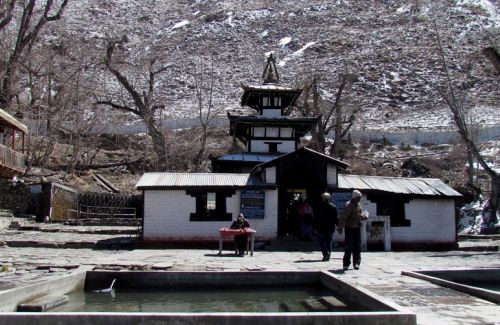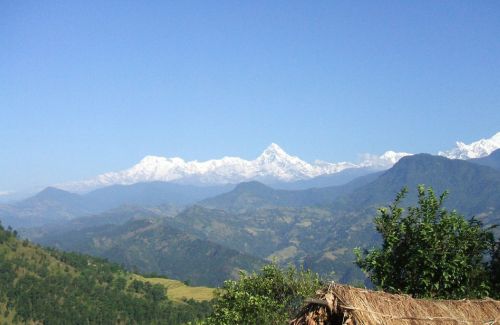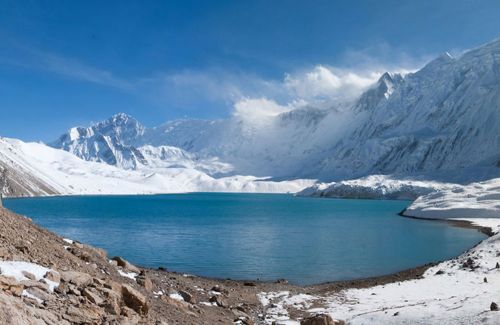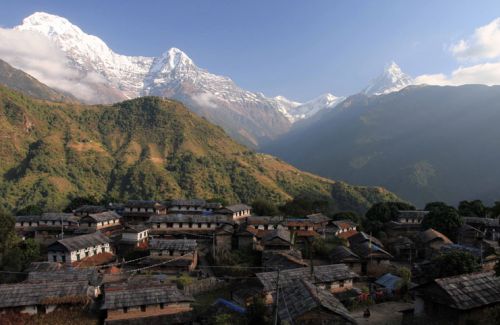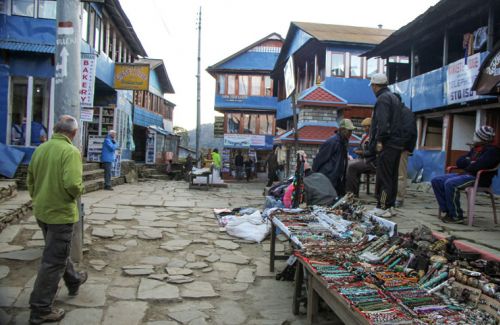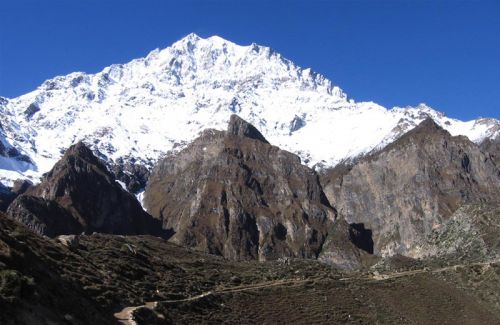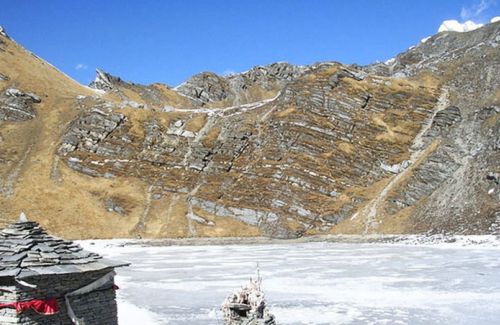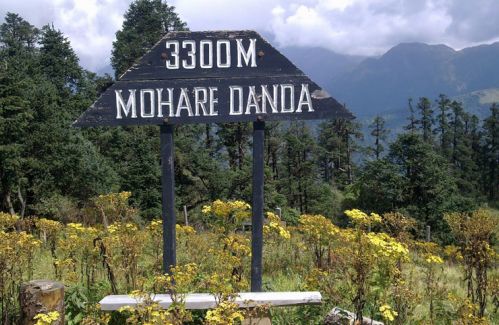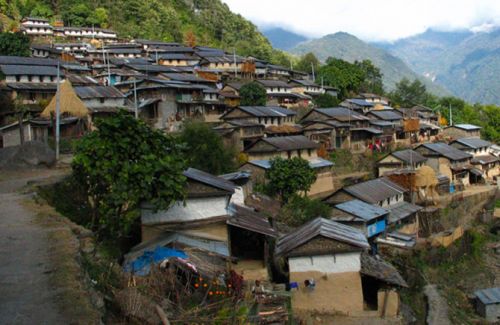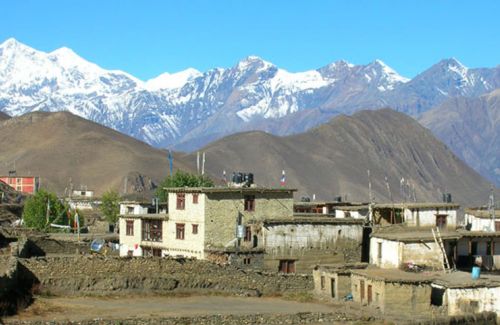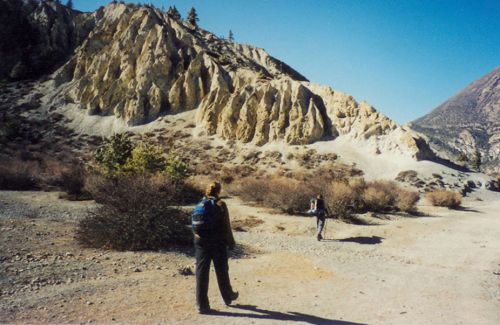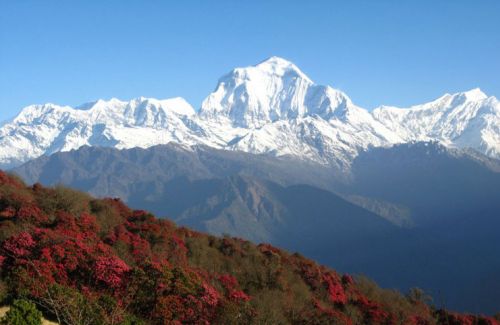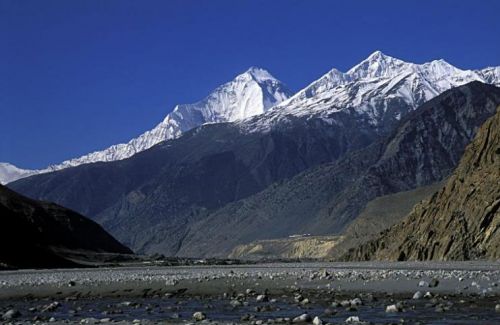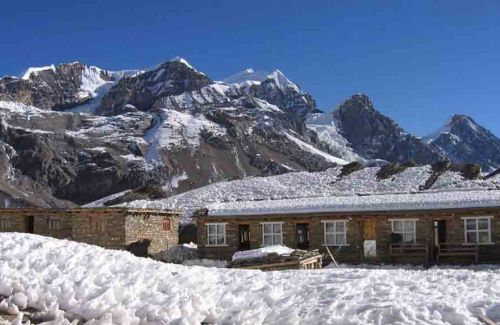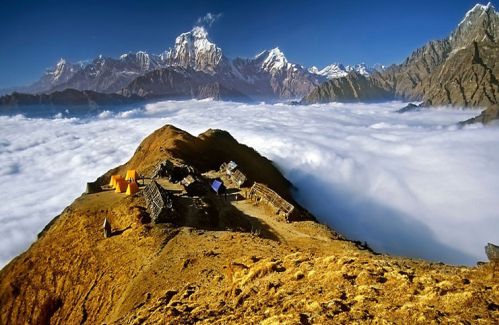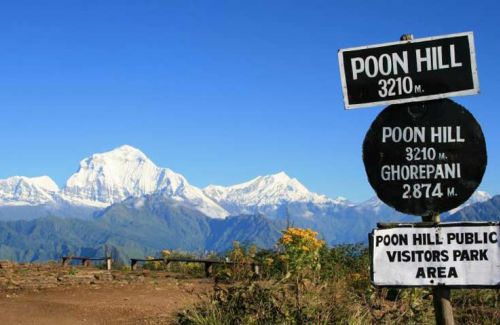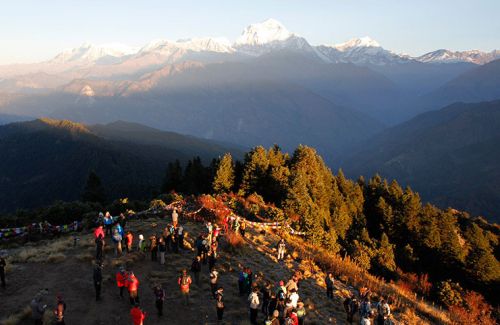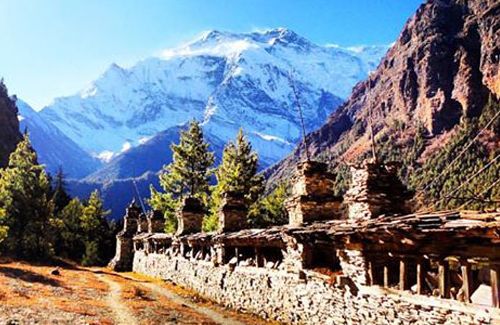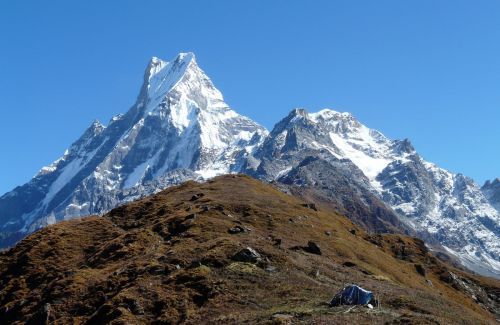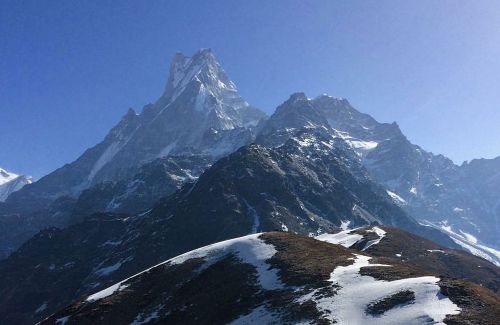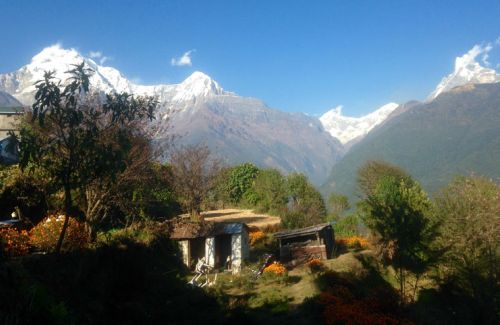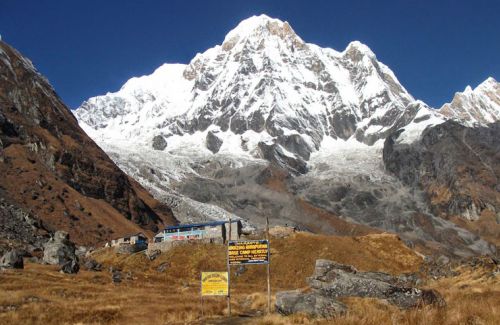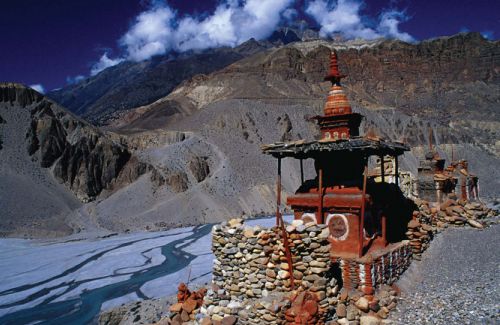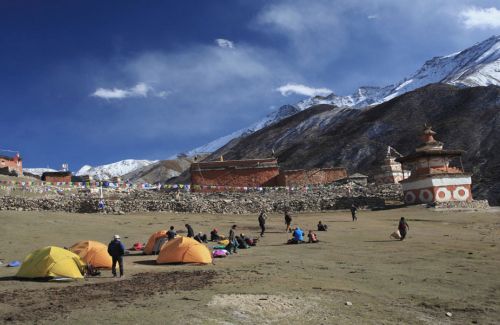Annapurna Base Camp Trek
- Duration17 Days
- Max. Altitude4,130 m.
- Starts FromUSD 1180
Destination:Nepal
Trip Grade:Moderate (**)
Meals:Breakfast + Lunch + Dinner
Transportation:Private Vehicle/Tourist Bus
Accommodation:Lodge
Trekking Destination:Pokhara, Poon Hill to Annapurna Base Camp
Show AllAnnapurna Base Camp Trekking is known as Annapurna Sanctuary Trekking. This is the most intensely scenic moderate trek in Nepal . The term Annapurna sanctuary ,coined by outsiders, denotes the high basin southeast of Annapurna and the headwaters of the Modi Khola. From Ghandruk on the Jomsom route the trail bears singlemindedly north into the very heart of the Annapurna range. Once past the sanctuary gate, it stumbles across moraines to a cluster of huts. Wherever you stand in the sanctuary, the 360 degrees views are unspeakably beautiful and although clouds roll early, the curtain often parts at sunset to reveal radiant, molten peaks. There are several possible routes to the sanctuary, all meeting at Chhomrong. The diversion from Jomsom and Annapurna treks is made from near Ghorepani to Ghandruk. Ghandruk is an affluent Gurung village.
Anapurna Base Camp Trek begins from Pokhara,an enchanting city nestled in the tranquil valley (827 m). This is the land of hardworking farmers,traders and valorous warriors who have earned worldwide fame as Gurkha soldiers. Clearly the most stunning of Pokhara’s sights is the spectacular panorama of the Annapurna range which forms its backdrop. It is Machhapuchhre,named fishtail in English which dominates all others in the neighborhood, boastfully levitating in the skyline, the fish-tailed pinnacle is the archetypal snow-capped, needle- pointed mountain.
“The route up the Modi Khola has always had the reputation among porters for being slippery and difficult. Indeed, back in 1969, on my first journey there, I had to chase after my porter, who ran ahead three hours towards Pokhara, rather than risk the possibility of going up the Modi Khola. Of course,when I had asked him previously about going up there, he said nothing in order to not to disappoint me!” , said by Stephen Bezruchka. So, the frequent precipitation makes the trail extremely slippery at the best of times and in winter it can be impassable due to snow or avalanche danger but the trail doesn’t live up to its old reputation. After Modi Khola, we head towards Annapurna Base Camp. We can return back through Jhinu Danda, then you could relax your tired muscles in the delightful hot springs. While returning back to Pokhara, we can feel Gurung culture in Ghandruk, Landruk.
So the trek to Annapurna Base Camp takes 7 to 11 days depending on how much time you would like to spend on walking days according to your itinerary. The best seasons to trek in this region are spring (February – April) and Autumn (September – November). The route in the spring is being studded with blooming colorful rhododendron, if you are a nature lover, the poet or an artist, you definitely lengthen your days to the trek. Few trekkers attempt to trek this reason even in the winter but there may be some hindrances due to bad weather, blocked trail and the lack of accommodation.
Himkala Adventure has been organizing such treks effectively always keeping in mind for your safety and well- being which is important paramount for us. As we have professional, trained and dedicated guides,our guests have fully enjoyed their trek.You can book Annapurna Base Camp Trekking with Himkala Adventure for your enchanting Himalayan journey. You may like other similar trip to Annapurna region like: Annaurna Circuit Trekking, Ghorepani Poonhill Trekking, Jomsom Muktinath Trekking, Tilicho Lake Trekking, Nar Phu Valley Trekking, Khayer Tal Trekking, Mardi Himal Trekking, Royal Trekking, Siklesh Trekking, and Upper Mustang Trekking. Please, contact us for further more information.
Trip Highlights
- Interesting City Tour around UNESCO World Heritage Sites in Kathmandu
- Exciting drive through Prithivi Highway from the bank of Trishuli and Marshyangdi River
- Scintillating mountain view from Poon Hill and Annapurna Base Camp
- Amazing glacier view at Annapurna and Dhaulagiri Icefall
- Interaction with different tribal people
- Rich Gurung culture and their tradition
- Enchanting city Pokhara Valley and Phewa Lake
- Wonderful Gurung villages Ghandruk, Landruk
- Highest view point at Annapurna Base Camp
- Hot Spring at Jhinu
Day to Day Itinerary
Day 01:Arrival in Kathmandu (1,350 m) and Transfer to Hotel. O/N at Hotel
Day 02:Kathmandu Sightseeing and Trek Orientation. O/N at Hotel
Day 03:Drive from Kathmandu to Pokhara (827 m), 7 hrs. O/N at Hotel
Day 04:One hour drive to Nayapul (1,050 m) and trek to Tikhedhunga (1,575 m), 4 hrs. O/N at Guest House
Day 05: Trek from Tikhedhunga to Ghorepani (2,840 m),6 hrs. O/N at Guest House
Day 06:Early morning Hike up to Poon Hill (3210 m) and trek to Tadapani (2,640 m), 7 hrs. O/N at Guest House
Day 07:Trek from Tadapani to Chhomrong (2,140 m), 5 hrs. O/N at Guest House
Day 08:Trek from Chhomrong to Dovan (2,500 m), 7 hrs. O/N at Guest House
Day 09: Trek from Dovan to Deurali (3,230 m), 6 hrs. O/N at Guest House
Day 10:Trek from Deurali to Annapurna Base Camp ( 4,130 m), 5 hrs. O/N at Guest House
Day 11: Trek from Annapurna Base Camp to Bamboo (2,345 m), 7 hrs. O/N at Guest House
Day 12:Trek from Bamboo to Jhinu Hot Spring (1,780 m), 6 hrs. O/N at Guest House
Day 13:Trek from Jhinu to Ghandruk (2,012 m), 5 hrs. O/N at Guest House
Day 14: Trek from Ghandruk to Nayapul (1,050 m), 5 hrs, then drive to Pokhara, 1 hr. O/N at Hotel
Day 15:Pokhara Valley sightseeing (Bindhawasini, Davis fall, Gupteshwor Cave, Tibetan Refugee Camp etc.)
Day 16:Drive from Pokhara to Kathmandu, 7 hrs, (Can fly if required). O/N at Hotel
Day 17:Departure to International Airport
Cost Include
- Airport picks up and drops off
- Drive Kathmandu – Pokhara – Kathmandu by Tourisr Coach
- Kathmandu/Pokhara Sightseeing
- Hotel in Kathmandu & Pokhara with Breakfast (Hotel Category as per your choice)
- Full Board meal during the trek
- Tea House, lodge, Guest House Accommodation during the trek
- Annapurna Conservation Area Entry permit
- TIMS (Trekker’s Information Management System) Fee
- Experienced English Speaking Trekking Guide
- Local Trekking Porters(2 Trekkers = 1 porter)
- Food, Salary, Accommodation and Insurance of Guide and Porters
- Down Jacket, Duffel Bag, and Sleeping bag by Himkala Adventure if required
- Government Tax,Service Charge and other applicable taxes
- Dinner after completion of your trek with Nepalese cultural show
Cost Exclude
- Lunch and Dinner in Kathmandu and in Pokhara
- Entrance Fees of all visiting monuments during tour
- Nepal Entry Visa Fee
- Personal Expenses ( Phone Bills, Bottled or Boiled water, Bar, Laundry, Shower etc.)
- Your Travel Insurance
- Emergency Rescue Evacuation
- Tips to Trekking, Tour Staff and Driver (Tipping is expected)
- Any other expenses that has not been mentioned in the Cost Includes Section
Detail Itinerary
Day 01Arrival in Kathmandu (1,350 m) and Transfer to Hotel. O/N at HotelYour arrival in Kathmandu (1350 m) at Tribhuvan International Airport after the custom formalities will be greeted by the Himkala representative in a great exaltation. You are transferred to the hotel and take a rest. In the evening, you can survey the touristic area, Thamel. Overnight at Kathmandu
Day 02Kathmandu Sightseeing and Trek Orientation. O/N at Hotel It is the perfect day for the city sightseeing and do trek preparation. First, after breakfast, we visit some UNESCO World Heritage Sites where one can see the medieval arts, architecture, crafts and get to be familiar with our history. The traditional norms and values through the ritual activites shown by typical Newar people of Kathmandu can succinctly be seen. The monks chanting “OM MANI PADME HUM” and walking around the stupa spinning prayer wheel in yellow or maroon dress develops the tranquility in mind. After all this experience, we come back to hotel and give you briefing about the popular trekking of Annapurna Base Camp trekking that goes from tomorrow till two weeks. Overnight at Kathmandu
Day 03Drive from Kathmandu to Pokhara (827 m), 7 hrs. O/N at Hotel There is option to go to Pokhara either by flight or by road. If we fly from Kathmandu to Pokhara, it takes 30 minutes and this offers the exciting aerial view to the hills, village settlements, forest and the series of mountains from west to the east, especially from Dhaulagiri to Manaslu. Driving from Kathmandu to Pokhara is also fabulous because the Prithivi Highway is in well maintained condition, 200 km of scenic beauty through green terraced hills, typical villages and the farming, meandering Trishuli, Budhi Gandaki and Marshyangdi Rivers and the close up Annapurna Massifs’ view from the way near to Pokhara.Overnight at Pokhara
Day 04One hour drive to Nayapul (1,050 m) and trek to Tikhedhunga (1,575 m), 4 hrs. O/N at Guest House Pokhara is the city of Lakes. It is the adventurer’s paradise and the gateway of trekking to Annapurna. After breakfast, we drive an hour from Pokhara (827 m) to Nayapul (1,050 m). After this the trail descend to the Modi Khola, follows its east bank southward a short distance to a suspension bridge and crosses towards Birethanti (1,097 m).After passing two settlements Lamthali and Sudami, we gradually climb up the side of the valley to Hille (1,524 m). After this the next destination is Tikhedhunga. Overnight at Tikhedhunga
Day 05 Trek from Tikhedhunga to Ghorepani (2,840 m),6 hrs. O/N at Guest House The trek from Tikhedhunga to Ghorepani is about 6 hours and full of fun through rhododendron and oak forest. First we reach to Ulleri (2,073 m) and after an hour from Ulleri, the trail goes up, crosses many streams, reaches to Banthanti(2,307 m). The trail finally reaches to Ghorepani (2,840 m) which is 3 hours walk from Ulleri. Overnight at Ghorepani
Day 06Early morning Hike up to Poon Hill (3210 m) and trek to Tadapani (2,640 m), 7 hrs. O/N at Guest House We get up early in the morning and set out for the hike to Poon hill where there is a view tower and 267 m higher than the pass on the ridge to the west. Within an hour we reach to Poon hill. It is the best vantage point for the astounding view of Dhaulagiri and the Kali Gandaki gorge. After a while we return back to hotel and have breakfast. Now, we climb along the ridges through the rhododendron and pine forests to Deurali (2,960 m). We go down to Banthati, then after a while, we arrive at Tadapani (2,640 m). Overnight at Tadapani
Day 07Trek from Tadapani to Chhomrong (2,140 m), 5 hrs. O/N at Guest House After breakfast, we head towards Chhomrong walking through jungle about 45 minutes and reach the place named Chuile. After this, we again trek down through the village and cross a bridge and cimb up to the place named Gurjung. We can have our lunch there. It is about 2 hours walk from Gurjung to Chhomrong. Overnight at Chhomrong
Day 08Trek from Chhomrong to Dovan (2,500 m), 7 hrs. O/N at Guest House Chhomrong is a beautiful, prosperous Gurung village. After breakfast, we start our trek going through a long set of stairs down to Chhomrong Khola about 395 m from Chhomrong, cross the suspension bridge and continue the slopes up to the crest of the ridge terracing the gorge and reach to Sinuwa. From Sinuwa to Bamboo, the trail passes through the secluded forest where from the top of the forest, the waterfalls shooting off the steep walls of the gorge. After this we reach to Dovan. Overnight at Dovan
Day 09 Trek from Dovan to Deurali (3,230 m), 6 hrs. O/N at Guest House Today, it is the trek about 3 and half hours from Dovan to Deurali, After one hour 15 minutes, we reach to the place called Himalaya at an elevation of 2,900 m. We trek passing rhododendron and bamboo forests, and reach to Hinku where there is a Hinku cave. After 2 hours of walk from Himalaya we, reach to Deurali, located at 322m high from the sea level. Overnight at Deurali
Day 10Trek from Deurali to Annapurna Base Camp ( 4,130 m), 5 hrs. O/N at Guest House After breakfast at Deurali, we gradually climb through a river bed over the vertical way to the mountain side. Hiking from Bagar to the Macchapuchhre Base Camp is tough, exhausting. After this the view from there is marvelous especially of Mt. Macchpuchhre, Mt. Hiunchuli, Annapurna Massifs and Gangapurna etc. We are not able to see the vegetation and the path broadens while entering to the Annapurna Sanctuary. We can go over the moraines under the cliff. There are few tourist lodges in the Machhapuchhre Base Camp. After 2 hours walk from the Macchapuchhre Base Camp, we reach to Annapurna Base camp.Overnight at Annapurna Base Camp
Day 11 Trek from Annapurna Base Camp to Bamboo (2,345 m), 7 hrs. O/N at Guest House We wake up early in the morning and snatch the sunrise view over the peaks from Annapurna Base Camp in our cameras. Then after breakfast, we retrace back to Bamboo through Machhapuchhre Base Camp, Deurali, Dovan and finally reach to Bamboo.Itis about 5-6 hours walk descending down to Modi Khola at an elevation of 1,700 m to hiking up to Bamboo at 2,345 m.The natural scene around Bamboo is inexpressible. The waterfalls from the higher cliffs and the Machhapuchhre popping out can be seen through the forest. There are few tea houses and lodges. Overnight at Bamboo
Day 12Trek from Bamboo to Jhinu Hot Spring (1,780 m), 6 hrs. O/N at Guest House After breakfast at Bamboo, we pass the landslide part, reach to Chhomrong and Sinuwa,then walk down, cross the river. After crossing river, we climb through steep way up to Chhomrong. From Chhomrong, it is about 45 monutes walk down to Jhinu Danda. The special feature of Jhinu Danda is ‘Hot Spring”. The hot spring is situated in the bank of Modi River; about 20 minutes walk from Jhinu Danda where there are two ponds. Overnight at Jhinu Danda
Day 13Trek from Jhinu to Ghandruk (2,012 m), 5 hrs. O/N at Guest House After breakfast at Jhinu Danda, we descend to a small stream and climb up the stone steps with undulating hill through the terraced fields, viewing Jhinu Danda and Chhomrong village from the top of the ridge. It takes about 2 and half an hour to reach the small village over the top of ridge from Jhinu Danda.After this, we further go through surging trail through the intense forest of rhododendron. The scenic stone roofed houses of Landruk and Ghandruk seem from a distance graceful. We reach to Ghandruk. Ghandruk is a typical Gurung settlement.We can visit the Gurung Museum and Handicraft center nearby. After our lunch, we can explore the local monastery and other side trips around the village. Overnight at Ghandruk
Day 14 Trek from Ghandruk to Nayapul (1,050 m), 5 hrs, then drive to Pokhara, 1 hr. O/N at Hotel After breakfast at Ghandruk, we trek down through the stone steps viewing Landruk in front of us. After 2 hours trekdown from Ghandruk village, we arrive at Syauli Bazaar, and then we follow the plain dusty road along the Modi Khola until we reach to Birethanti which takes 1 and half an hour from Syauli Bazaar. We cross the suspension bridge and have lunch there. After lunch, it is just 30 minutes walk from Modi Khola to Nayapul. It is about an hour drive from Nayapil to Pokhara then transfer to Hotel. Overnight at Pokhara
Day 15Pokhara Valley sightseeing (Bindhawasini, Davis fall, Gupteshwor Cave, Tibetan Refugee Camp etc.) After breakfast around 9 am, we begin our city tour from the Bindhawasini temple; the powerful Hindu goddess where there are ritual activities can be seen. Then we proceed to Seti River gorge and see how Seti River has made the gorge and flower underground. After this, we turn to south towards Davi’s fall and see the water drained from Phewa Lake falls, goes one kilometer down and mixes with Set River. The Gupteshwor Mahadev cave is very close to Davi’s fall. We visit the cave and go to Tibetan Refugee Center where we can see the Tibetan people weaving and making the quality carpets. After this, we drive back to the Phewa Lake and go for the lunch in the restaurant which has faced towards Phewa Lake.After Lunch, we go foe an hour boating, visit Tal Barahi temple in the small island and come back to hotel. Overnight at Pokhara
Day 16Drive from Pokhara to Kathmandu, 7 hrs, (Can fly if required). O/N at Hotel After breakfast, we transfer to the Pokhara airport. It is 30 minutes flight, viewing the fascinating scene. If not, we drive back to Kathmandu, 200 km from Pokhara, takes 6-7 hours, viewing beautiful hill scene and rural life. In the evening, Himkala arranges the dinner with Nepali Cultural Show. Overnight at Kathmandu
Day 17Departure to International Airport We transfer you to the airport 3 hours before your flight. So, as per your flight schedule, we check out from the hotel and leave you at International terminal side at airport with showing gratitude joining with Himkala Adventure for the trek to Annapurna Base Camp. Namaste with Palms together
Trip FAQ
The Basics
What physical fitness do I need to book this trip?
Trekking in the Himalayas of Nepal involves lengthy, multi day walks and climbs on village and park trails, and thus requires a certain level of physical and mental fitness. You should feel comfortable hiking 10-20 km per day carrying a day pack of about 5 kg. In addition, plan on doing at least one hour of aerobic activity 3-4 times per week for at least 1 month before your arrival in Nepal. Walking, jogging, cycling, and hiking are some excellent forms of exercise, so long as you are strengthening leg muscles and building stamina. Aerobic conditioning is important primarily because you will be trekking in thinner air, up to 40% less than at sea level. With good aerobic conditioning, you will be able to better metabolize whatever oxygen is available to you.
What is the minimum number of trekkers required for this trip?
There is no minimum. If you are a solo traveler, you are welcome to sign up. We also can arrange group trips to Annapurna Base Camp.
Our Guides
Who will be guiding me during this trip?
Our guides are trained by the Nepal Academy of Tourism and Hotel Management, certified and approved by the Tourism Department of the Nepal government. The guides hold professional English speaking licenses and we can also provide French, Spanish, Japanese, German and Italian speaking guides by request. Our guides are local Nepali people who have been carefully selected on the basis of their appropriate experience, leadership skills and personality.
What sort of experience do your guides have?
Our trekking guides are experts in Himalayan trekking and have on average over 10 years of trekking experience. Many of them are from neighboring villages and have a lifetime’s worth of knowledge about the routes and precautions to take. In addition to having their guide certification, all our guides have a hold at least a Master’s Degree and have excellent command of the English language. They are also trained in first aid.
Transportation and Accommodation
How do I find Himkala Adventure for the airport pick up?
Our representative from Himkala Adventure will display a small placard of company or your name outside the airport terminal. You will be driven to the hotel by our tourist vehicle.
What mode of transportation do I use?
We will provide private transportation for Airport/Hotel pick up and drop off and sightseeing in Kathmandu Valley.
What is the baggage allowance from/to Kathmandu – Pokhara flight?
We also offer trekkers the option to fly from Kathmandu to Pokhara. It is scenic flight over the mountains which takes 25 minutes. Different airlines have different restrictions but in general, passengers are allowed to carry 20 kg of check-in luggage.
What sort of accommodation do I get in Kathmandu and Pokhara?
We provide standard rooms with twin sharing accommodations at three star hotels in Kathmandu including breakfast. Accommodation can be upgraded by request. Some of our packages are sold without accommodation as well.
What sort of accommodation do I get in trekking?
Guesthouses/Teahouses/Lodges provide twin sharing single and double rooms and occasionally a dormitory. These come with clean mattresses and a quilt or blanket. Our company provides sleeping bags if needed but we always recommend having your own sleeping equipment. You will be sharing the room with your other trekkers. The toilet is always outside the room with basic facilities.
What are Teahouses?
Teahouses offer a unique mountain trekking experience in which lodging and meals are offered. Teahouses are simple but neat and clean and provide fresh and hygienic food in a friendly local atmosphere. Most have running water, with many of them having hot water for bathing.
What sort of food, water and drinks can I expect in trekking?
You will have your breakfast and dinner at the lodges where you will be staying and lunch during the trek. The food in the Himalayas is very simple but hygienic, fresh, and delicious. Most meals are vegetarian. Meals are prepared by locals who have years of experience providing food to trekkers on this route. You will have the chance to enjoy different varieties of delicious Nepali dishes! The most popular Nepali food is daal bhat (rice and lentils) with some mixed vegetable curry. Garlic soup is popular as it helps you with acclimatization. We recommend you to drink mineral water or boiled water with water purification pills or drops. You can also find other drinks like hot chocolate, coffee, tea, hot lemon water with honey, ginger tea, and soft drinks.
Preparation
What is the best season for this trekking?
The best season for Anapurna Base Camp trek is spring (March to May) and autumn (September to December). These are the perfect time of the year for the breathtaking views of Himalayas.
What is the weather and temperature like during the trekking?
The climate in Nepal varies from place to place which can be categorized in different four main seasons. The main seasons in Nepal are spring (March to May), summer (June to August), autumn (September to November) & winter (December to February). The best season to travel in Nepal is autumn (September, October & November) & spring (March, April & May). Weather in the mountains is unpredictable, but the day temperature in Annapurna Base Camp trekking is comfortable.
What type of shoes should I wear during Annapurna Base Camp trekking?
We recommend hiking boots made of strong but light material with extra laces. It is best to buy shoes and boots before arriving in Nepal. We advise you to wear your new shoes for sometime before the trek to break them in.
Do I need to have insurance for this trip?
We request you to have a travel-insurance policy to cover theft, loss, medical problems, and emergency helicopter evacuation from high altitudes before coming to Nepal. Please make sure your travel insurance policy includes mountaineering or alpinism, as well as international medical evacuation insurance to cover an emergency helicopter evacuation or a charted flight from the remote mountain trails. Without insurance, a helicopter evacuation might cost $2500-$10000 USD depending on the location.
During the Trek
May I charge my electronic gadgets during Annapurna Base Camp trek?
Most teahouses have charging facilities. You can charge your devices by paying some extra money. It’s recommended to bring a travel adapter and to put your gadgets in a warm place at night.
How much additional money is required for this trip?
In Kathmandu you can allocate about 10-15 USD per person per meal. During the trek, 10-15 USD 10 to USD per person per day will be sufficient to buy bottled water, chocolates, and hot showers during the trek.
Are there communication or internet services during Annapurna Base Camp trek?
All guesthouses/lodges along the Annapurna Base Camp trail have telephones and internet services. They provide WIFI service for an extra charge. All our guides carry a local mobile phone. You can use his mobile phone to make any local or international call from trekking trails by paying him directly. We highly recommend having a local SIM card for call and internet services during trekking. Local SIM cards are easily available in many stores and at the airport as well. You will need to provide a passport photo and a copy of you passport to get a local SIM card from NCELL or NTC, the only 2 mobile providers in Nepal.
Can I use credit cards in the Annapurna Base Camp trekking route?
No, you can only use credit cards in cities like Kathmandu. It is better to exchange money in Kathmandu before you go to the mountains. Outside of the cities, it is best to have cash, and in small notes.
May I get a chance to shower during Annapurna Base Camp trek?
Showers will be provided in the form of buckets of water. Most of the guesthouse provide hot water at an extra cost.
May I add extra days in trekking?
If you have more days to spare, you could easily extend your trek with some side trips to the nearby Sherpa Villages or can deviate to other routes. If you would like to customize or shorten your trip, it is possible as well.
What happens in case of emergency?
Himkala Adventure is prepared for any emergency situation. Our guides are trained in first aid and can deal with most of the basic ailments that occur during the trek. Every client should have his own insurance before coming to Nepal in case of emergency.
Do I need to tip my guide and porter? How much would that be?
Tipping is not mandatory but it is a greatly appreciated way of showing gratitude after you have completed this trek. We recommend you to tip a minimum 10% of your total trip cost for tipping the local staff. The ratio of tipping breakdown between the guide and porter will be given to you at the pre-trip meeting in Kathmandu before starting the trek.
What is the social and environmental responsibility of Himkala Adventure for this trip?
The environmental situation in Nepal is threatened by global warming, human activities, and the adverse effects of natural incidents. With the ozone layer depleting, the atmosphere is getting heated and the snow in the Himalayas is melting day by day, causing sea level to rise. Population growth is causing deforestation and soil erosion in Nepal. Himkala Adventure is concerned with the social and environmental implications of trekking. We are very conscious of not littering in the open spaces and manage garbage properly. We are working together with other companies and the local people in taking these issues seriously.
Trip Note
Cost:
The cost of trip will vary according to the number of travelers in the group, the quality of the hotel requested, and the mode of transportation. Please contact us with further details about your trip to get a quote of the exact price.
Essential Documents:
You are requested to send the following documents after you confirm or book the trip with Himkala Adventure:
- A copy of your passport
- Travel/health insurance documents with contact details
- Three passport size photos.
It is advised to maintain a separate photocopy of all important documents including traveler’s cheques, bank/ATM cards, contact numbers, international flight tickets, and emergency contact numbers.
Weather:
The main trekking season in Nepal is from October to December and March to May. The day temperature for walking to Annapurna Base Camp is comfortable. The sky is clear, with occasional snow and rainfall. Temperatures start at about 10 degrees centigrade at a height of 3,600 m and will drop the higher we trek.
Transport:
A traveler to/from Pokhara is allowed to carry 20 kg of check-in luggage.
Nepal Strikes:
There may be Bandha (Nepal transportation strikes) at a very short notice. However, the shuttle bus in operation by the Nepal Tourism Board and the Nepal Tourist Police does not participate in these strikes and you can travel from the domestic and international terminals to various hotels in Kathmandu for 300 rupees per person.
Itinerary Disclaimer:
Please note that some changes may occur in our itineraries due to bad weather and common seasonal changes in timetables and transport routes.
Physical Fitness Readiness:
You will be walking up to 5,545 m above sea level. As the geographical region varies, there is a temperature variation as well. We advise you to undertake regular physical exercise, jogging, hiking, riding, ascending and descending stairs, etc. in preparation for this trek.
Group Size:
Himkala Adventure organizes treks for solo and group travelers. Group travelers will share accommodation, separated by gender. Solo travelers will get a single accommodation, and are subject to a supplement charge.
Accommodation and Meals:
Accommodations at local lodges are simple but clean and comfortable. Toilets and washing facilities are shared and rudimentary. The food is simple but nourishing. In high altitude regions, there are very few tea houses with electricity or hot water. Hot showers are available by request for an added fee.
Money Matters:
Please note that most establishments and banks in Nepal will not accept foreign currency notes that are old, torn or faded. Please ensure that you have crisp, clean notes.
The official currency of Nepal is the Nepali Rupee (NPR). ATMs can be found only in major cities of Nepal like Kathmandu, Pokhara, Chitwan, Bhaktapur etc. The government of Nepal has banned the import, export and use of 500 and 1000 Indian rupee notes in Nepal. Make sure to avoid carrying these notes when traveling into Nepal, otherwise they may be confiscated and you may be fined.
While travelers cheques have the advantage of security, exchanging them can be a lengthy process, commissions can be high (up to 10%) and they can be difficult to change in rural areas, on weekends and public holidays. If you choose to bring travelers’ cheques, make sure they are a major brand and major currency.
Tipping:
Tipping is not mandatory and is entirely a personal preference. Himkala Adventure recommends you tip separate members of the trekking staff instead of giving all your tips to the trekking staff group leader. Please do not tip with coins or dirty and ripped notes. This is culturally taken as an insult.
Local Dress in Nepal:
Nudity is a sensitive issue in Nepal. Women should avoid wearing shorts and sleeveless tops in public places where this might be seen as inappropriate. Remove shoes before entering certain holy places. Non-Hindus are not permitted in some temples.
Feedback:
Your feedback is welcomed and we are always eager to hear suggestions from you.
Trip Info
- Travel Insurance and Evacuation
- Trip FAQs
- Washing and Shower
- Water/Food and Nutrition
- Trip Grading
- Weather
- Accommodation/Shelter
- Altitude Sickness
- Communications and Updates
- Conservation
- Cross Cultural Issues
- Essential Do’s and Don’ts
- Foot Ware/Foot Care
- Health and Fitness
- Himkala Crews
- Hypothermia
- Safety and Security
- Equipment List
What our clients say?
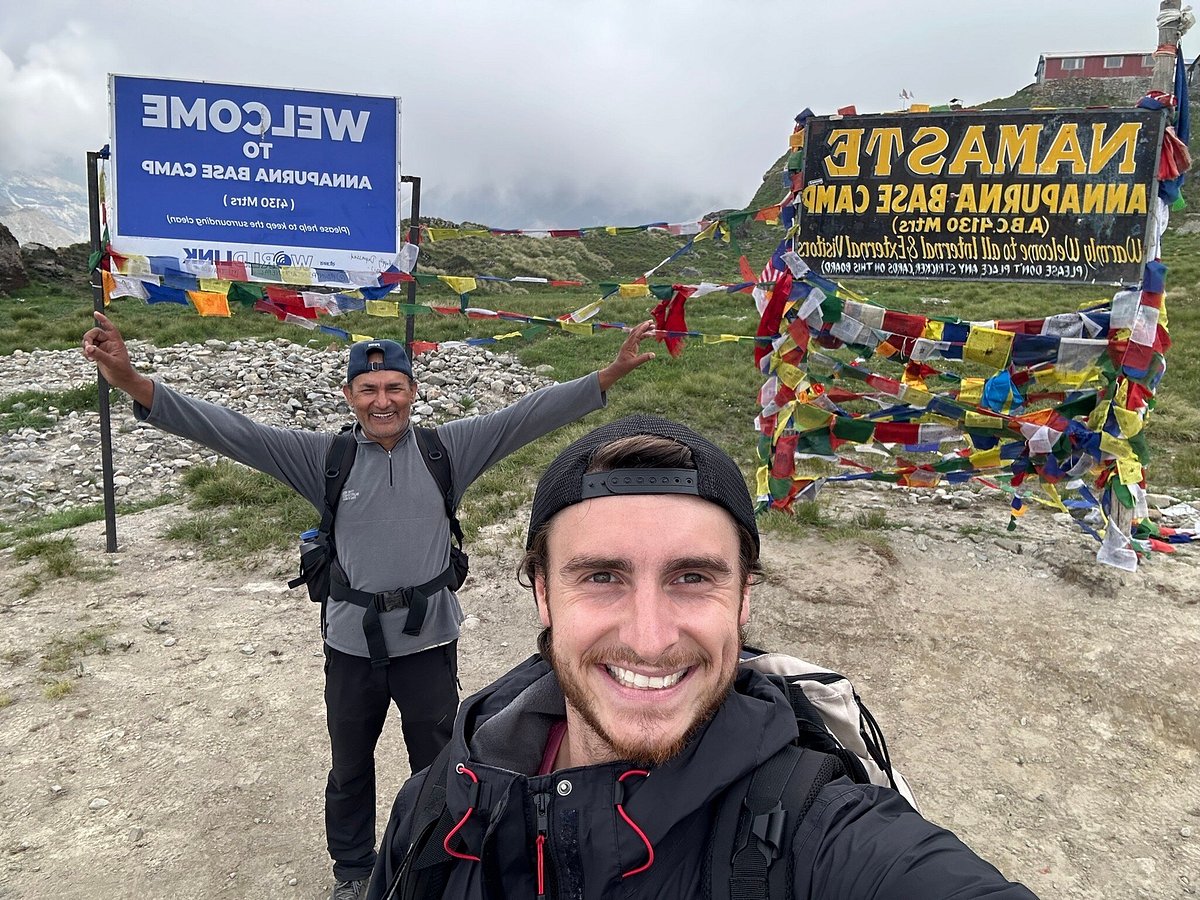
Cette expérience a été vraiment géniale pour moi. J’ai eu l’occasion de faire le camp de base de l’Annapurna sur 7 jours de trek. Nous avons marché de villages en…...
Nathan V, France
Read More